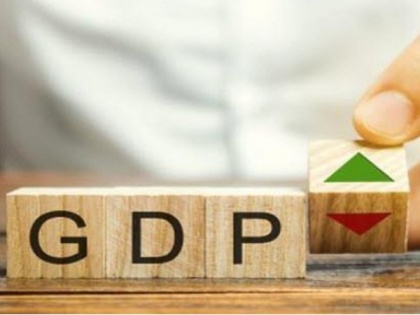India's FY24 GDP growth is likely to be higher than threshold 6 per cent: Report
By ANI | Published: March 1, 2023 01:15 PM2023-03-01T13:15:02+5:302023-03-01T18:50:01+5:30
A SBI Research report said India's FY24 GDP growth is likely to be higher than the threshold 6 per ...

India's FY24 GDP growth is likely to be higher than threshold 6 per cent: Report
A SBI Research report said India's FY24 GDP growth is likely to be higher than the threshold 6 per cent. The report, titled Ecowrap, added though some reports indicated that there may not be a one-to-one correspondence between El Nino and Indian droughts, the recent fears seem misplaced.
In the report, Soumya Kanti Ghosh, group chief economic advisor, SBI, said, "We are also not overtly concerned regarding the recent news of El Nino. Looking at the relation between El Nino and Indian droughts since 1950, it is observed that India faced 13 droughts, and 10 of these were in El Nino years and one in a La Nina year."
Private final consumption expenditure (PFCE) is expected to increase to Rs 164 lakh crore in FY23 (2022-23), with the yearly growth moderating to 14.8 per cent, said a research report by SBI.
Historical data showed that PFCE declined at the current price for the first time in FY21 (2020-21) in a decade, according to the report titled Ecowrap. Prior to Covid-19 pandemic, it continued to grow at double digits with an average of 12 per cent, though the pace of increase has been on the decline since FY18 and it turned negative in FY21. The report said the growth rate in PFCE moved back to double digits post-Covid, indicating positive growth momentum.
The jump in per capita GDP in FY23 is Rs 25,218 at current prices, it added.
Private final consumption expenditure is defined as expenditure on goods and services for the direct satisfaction of individual needs.
Per capita PFCE also shows an improvement of over 10 per cent year-on-year to Rs 63,595 crore in FY22 after dipping to Rs 57,728 crore in FY21.
Meanwhile, gross capital formation (GCF) in agriculture, manufacturing, electricity, trade and hotels, real estate, public administration and other services sectors registered a new peak in FY22 after dipping during the pandemic, according to the report. The trends in GCF to gross output ratio or the plough back of funds for the creation of fresh capacity shows no specific trend, except for public administration where the ratio attained fresh peak in FY22, owing to the emphasis on capital expenditure in recent Budgets.
GDP grew 4.4 per cent during Q3 FY23, softer than 13.2 per cent growth in Q1 and 6.3 per cent growth in Q2 exhibited earlier. The report said this was in sync with broader market sentiments at lower end of spectrum.
For the full fiscal, GDP growth is expected to increase by 7 per cent and gross value added (GVA) growth by 6.6 per cent. Based on the FY23 yearly numbers, Q4 GDP growth should be coming around 5.1 per cent, based on an unchanged base, Ecowrap said, adding revisions across the board in both yearly and quarterly growth numbers of recent past have seen real GDP growth for FY20, FY21 and FY22 being revised upwards by 20, 77 and 42 bps, respectively.
With respect to the current fiscal, the Q1 FY23 GDP growth was revised downwards by 32 bps. Due to the upward revision in FY22 GDP numbers (by 42 bps), the fiscal deficit of FY23 as percentage of GDP will now be revised upwards to 6.5 per cent from 6.4 per cent of GDP, according to the report --Ecowrap. For FY24, there will be no change in fiscal deficit due to revisions. The sectoral GVA indicate that all the sectors have crossed the pre-Covid level, the report added.
Sector-wise, agriculture and allied activities accelerated by 3.7 per cent in Q3 FY23 against 2.3 per cent Q3 FY22, manufacturing grew by 2.4 per cent, against 1.6 per cent in Q3 FY22 though it had declined by 0.4 per cent in the preceding quarter i.e. Q2 FY22, while services embraced a 6.2 per cent growth.
The sluggish growth in manufacturing came primarily due to the contraction in manufacturing sector at 1.1 per cent though electricity, gas, water supply and other utility services and construction sector grew by more than 8 per cent during the quarter, the report said. It added 'public administration, defence and other services' under services had a moderate growth of 2 per cent while 'financial, insurance, real estate and professional services' share showed increasing trend with higher growth compared to other 2-sub sectors -- trade, hotels and public administration.
The report ended with an anecdote. It said unpaid domestic work was an important aspect of productive activities and an indispensable factor that contributes to the well-being of household and economy.
However, "the predominance of women in domestic work and keeping them out of 'economic activities' put unpaid domestic work under the shadow of invisibility, outside the production boundaries, and further outside the purview of economic policy," Ecowrap said.
To understand the status of women in the labour market, it is necessary to comprehend the nature of their unpaid work, which has significant impact on their work participation rate in the economy, the SBI Research report said. Its analysis indicated that the total contribution of unpaid women to the economy is around Rs 22.7 lakh crore which consisted of rural -- Rs 14.7 lakh crore and urban ,valued at Rs 8.0 lakh crore -- which is almost 7.5 per cent of the India's GDP.
( With inputs from ANI )
Disclaimer: This post has been auto-published from an agency feed without any modifications to the text and has not been reviewed by an editor
Open in app